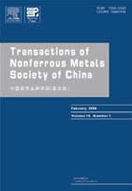Corrosion degradation behavior of Mg-Ca alloy with high Ca content in SBF
(1. School of Materials Science and Engineering, Tianjin University of Technology, Tianjin 300384, China;
2. School of Mechanical, Materials and Mechatronic Engineering, Faculty of Engineering and Information Sciences, University of Wollongong, Northfield Ave, Wollongong, NSW 2522, Australia)
2. School of Mechanical, Materials and Mechatronic Engineering, Faculty of Engineering and Information Sciences, University of Wollongong, Northfield Ave, Wollongong, NSW 2522, Australia)
Abstract: The corrosion degradation behavior of a Mg-Ca alloy with high Ca content aiming for a potential bone repair material in the simulated body fluid (SBF) was investigated. The microstructure and phase constitution of the pristine Mg-30%Ca (mass fraction) alloy were characterized with scanning electron microscopy (SEM) and X-ray diffraction (XRD). The Mg-30%Ca alloy samples were immersed in the SBF for 90 d, and the morphology, composition and cytotoxicity of the final corrosion product were examined. It is found that Mg-30%Ca alloy is composed of α-Mg and Mg2Ca phases. During the corrosion process in the SBF, the Mg2Ca phase acts as an anode and the α-Mg phase acts as a cathode. The final corrosion product of the Mg-30%Ca alloy in SBF includes a small amount of black precipitates and white suspended particles. The white suspended particles are Mg(OH)2 and the black particles are believed to have a core-shell structure. The cytotoxicity experiments indicate that these black precipitates do not induce toxicity to cells.
Key words: Mg-Ca alloy; corrosion behavior; corrosion product; cytotoxicity

